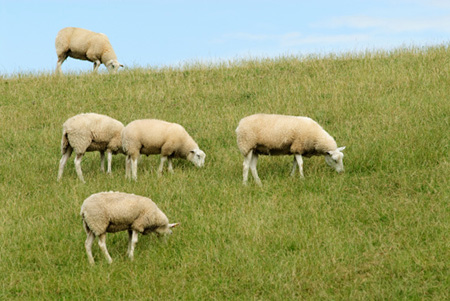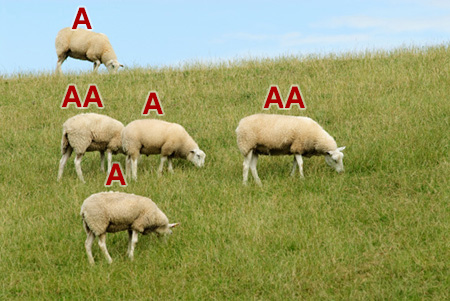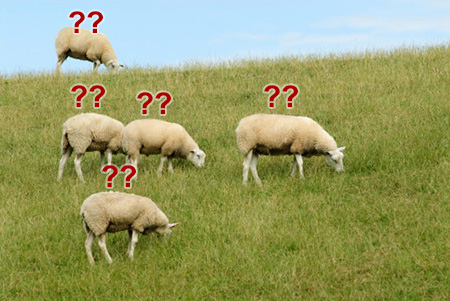The Hardy-Weinberg principle states that the proportion of alleles will stay constant from generation to generation unless the population is evolving. We can state this another way: Allele frequencies do not change unless evolutionary forces act on the population. Frequency is the proportion of a group that is of one type. For example, an allele frequency is the proportion of that allele out of all the alleles for that gene in that population. How do we figure out the allele frequencies so that we can determine whether a population is evolving? Read each tab below to learn about this process. At each step, there will be a problem to solve so you can practice calculating allele frequency. You should have a pencil and paper ready.
Calculating Total Alleles
Calculating Allele Frequency
Using Allele Frequency
The Other Allele

We calculate allele frequency by dividing the number of a particular allele in the population (like A or a) by the number of total alleles in the population (A + a). How do we know how many total alleles are in the population for a given gene? If the organism is diploid (as humans are), it has two alleles for each gene. To calculate the total number of alleles, you multiply the size of the population by two. For example, if there are 5 sheep, each one has 2 alleles for a given gene (because they are diploid organisms). So there will be a total of 10 alleles in the population.
If a population contains 100 people, how many alleles are there in the population for a given gene?
2 alleles per person x 100 people = 200 alleles total

Now that we have the total number of alleles for this gene in the population, we can calculate allele frequency. If 7 of the 10 sheep alleles are A, the frequency of A = \(\small\mathsf{\frac{7\text{ A}}{10\text{ total alleles}}}\) = 0.7.
If each person in the population of 100 has one A allele and one a allele, how many A alleles are there? What is the frequency of the A allele?
There are 100 A alleles. The frequency of A = \(\small\mathsf{\frac{100\text{ A alleles}}{200\text{ alleles total}}}\) = 0.5.

If we have the frequency of an allele and the size of the population, we can work backwards to figure out how many times that allele appears in the population. In the last example, if you were told that the frequency of A in a population is 0.7, then you know this means that the proportion of all the alleles in the population that are A is 0.7 out of 1 (7 out of 10). If the population has 5 sheep in it, you know there are 5 sheep x 2 = 10 alleles total for this gene. You can compute the exact amount of A alleles present: (10 total alleles) (\(\small\mathsf{\frac{0.7 A alleles}{total alleles}}\)) = 7 A alleles.
If you know that the frequency of A for a gene in a population of people is 0.5, and there are 100 people, how many A alleles are there?
100 people x 2 = 200 total alleles. 200 total alleles x 0.5 = 100 A alleles.

If there are only two possible alleles for a given gene, their proportions will always add up to 1. Any allele that isn’t an A must be an a. Thus, if we have the frequency (proportion) of one allele for a gene, we can calculate the frequency of the other. We do not need to know the size of the population to do this. For example, if you know that the frequency of the A allele in a population of sheep is 0.7, what is the frequency of the a allele? 1 - 0.7 = 0.3.
If you know that the frequency of the A allele in your population of humans is 0.5, what is the frequency of the a allele?
The frequency of the a allele = 1 - 0.5 = 0.5.
Here are two more practice problems to test your understanding.
If you have a population of 30 frogs and they have 40 A alleles for a gene, what is the frequency of the A allele?
- 40
- 60
- 0.40
- 0.67
If there are 30 frogs, there are 2 x 30 = 60 alleles for each gene. If 40 of those 60 alleles are As, then the frequency of the A allele is 40/60 = 0.67.
If there are 30 frogs, there are 2 x 30 = 60 alleles for each gene. If 40 of those 60 alleles are As, then the frequency of the A allele is 40/60 = 0.67.
If there are 30 frogs, there are 2 x 30 = 60 alleles for each gene. If 40 of those 60 alleles are As, then the frequency of the A allele is 40/60 = 0.67.
If there are 30 frogs, there are 2 x 30 = 60 alleles for each gene. If 40 of those 60 alleles are As, then the frequency of the A allele is 40/60 = 0.67.
How many a alleles will there be in this population?
- 20
- 30
- 40
- 60
If there are 60 alleles and 40 of them are A, the number of a alleles is 60 - 40 = 20.
If there are 60 alleles and 40 of them are A, the number of a alleles is 60 - 40 = 20.
If there are 60 alleles and 40 of them are A, the number of a alleles is 60 - 40 = 20.
If there are 60 alleles and 40 of them are A, the number of a alleles is 60 - 40 = 20.
Summary
 Questions answered correctly:
Questions answered correctly:
 Questions answered incorrectly:
Questions answered incorrectly:
